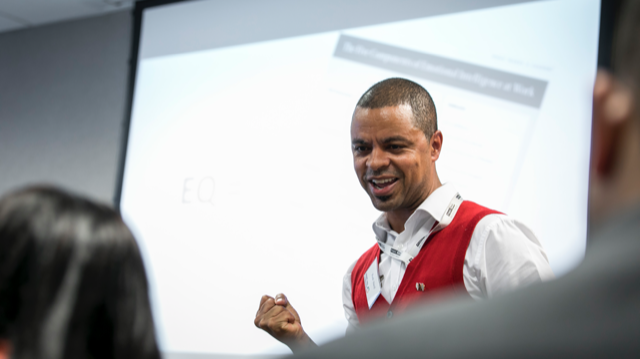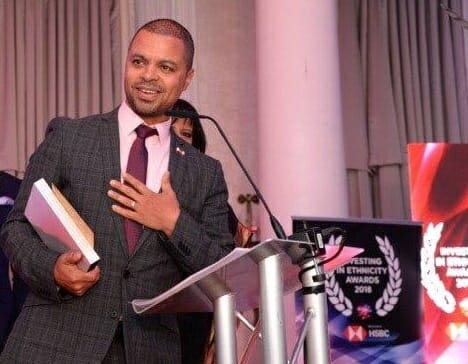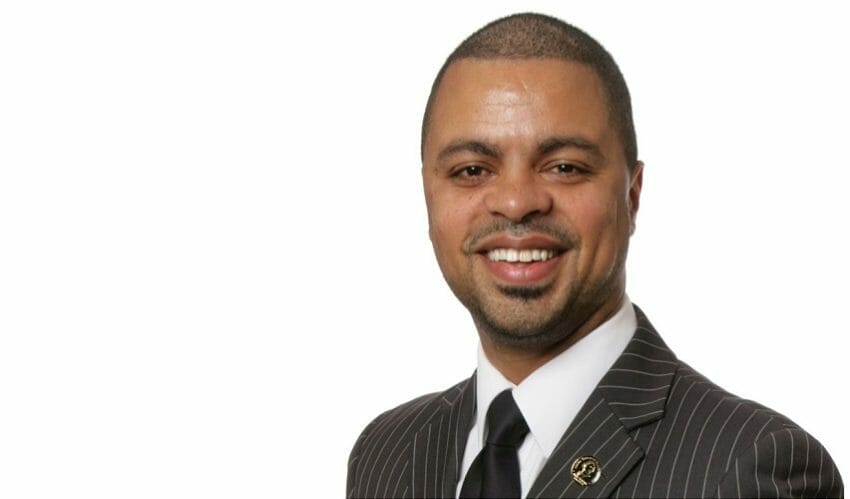He has a distinguished track record in employee engagement, is a former chair of the Civil Service Race Forum and was awarded an OBE in 2018 for services to race equality in the workplace and the community.
MoJ’s Project Race was set up in May 2015 and has delivered a range of positive actions in support of BAME talent. In April of this year, as MoJ’s Project Race came to an end, Rob started a new role first as the strategic delivery lead for Digital, Data & Technology at DfE before also being appointed as head of culture change & leadership, DfE.
How was Project Race formed?
There were three of us who, one day sat down and decided we had to do something about what was happening within and across the business – we’d had a couple of people come along to us that week with some horrendous examples as to what they’d faced. Enough was enough.
When we first started this work early in 2015, we were known as the MOJ’s race project. That didn’t feel right; it sounded too temporary. So we went to our internal comms and branding people to start knocking around ideas and walked out as Project Race, and soon after one of the Race Champions came up with the strapline: big, bold, brave. We now have a newsletter called B3, which is a nod to the three B’s; and there are people who literally, I kid you not, can hardly wait for the next issue to come out.
What did your role involve?
As the Head of MoJ’s Project Race, my role was to encourage the MOJ’s journey in becoming race confident. Racist behaviour and racism are different things. One can emanate from the other, but the actual systemic racism is what I wanted us to address because I think if we can get that right, the racist behaviour will no longer be tolerated.
What was your methodology?
At Project Race, we designed, delivered and evaluated discussions about race and race equality with senior teams with a view to normalising the conversation about race. Many of those conversations were upon invitation, and we delivered over 100 of them across two years. Some had arisen following staff engagement surveys, others as a result of feedback from network members.
I also reviewed staff ‘away-day’ outcomes where teams typically meet off-site to discuss what they needed to focus on, how they would work together and share needs around inclusion, e.g. specifically around race equality where the data highlights a priority.
Typically, we would then propose a session at their next ‘away-day’ during which we facilitate a bespoke activity that looked at the genesis of bias – i.e. both unconscious and conscious, white privilege, white fragility and the cognitive dissonance that takes place when bias occurs. What causes a leader to defend an inappropriate comment, a racist email or any other microaggression of some kind, rather than see it for what it is and deal with it appropriately?
We would then move the session on to focus on action planning, using our 2018 Race Equality Action Plan, aka the MoJ’s RAP. The RAP is now part of business as usual, not an add-on, and we actively helped parts of the business to work through it. Having made it onto the BITC’s Best Race Employers List in successive years, the MoJ has also signed up to the BITC’s Race at Work Charter, and Project Race ensured that the MoJ were signed up as Champion Level members. This external scrutiny has helped with the future-proofing of our commitment to Race Equality, a critical game-changing principal in our approach.
We would end the workshop with a session on ‘investment in intrinsic owners’. By this, we mean prioritised development specifically for BAME staff such as; sponsorship, learning and development, and reverse mentoring, i.e. the pairing of BAME members of staff with white SCS (senior civil service) colleagues.
SCS are often the decision makers and via reverse mentoring BAME staff can share their cultures, ‘lived experience’ and the ‘ground truth,’ i.e. what is really going wrong in the organisation. The quality of the outcome will always depend on the exchange that takes place; but our aim was to make reverse mentoring a part of MoJ’s corporate objective, with close ties to both of MOJ’s BAME staff networks, namely PROUD and Rise.
Are BAME members of staff comfortable talking to their white mentor about what actually happens?
Well, I can’t vouch for all. All I can say is that I am in a mentoring relationship with a senior white person whom I’ve met with several times and been able to share views, perspectives and, ultimately, more of who I am. There is no way of knowing for sure if the conversations that need to happen, are taking place, but at least people are being given the opportunity.
How did you measure Project Race’s progress?
I was invited to chair the MoJ’s Diverse Leadership Taskforce [DLT], which met monthly. The DLT was tasked with delivering on our published flow targets up to 2025, i.e. agreed targets aimed at achieving a more reflective workforce at SCS level in respect of both BAME and people with a disability.
Two other things are more directly measured, one of which is the ‘recordings rates’ of personal data on the system. When we started Project Race, 86% of white staff recorded their personal data, which was not bad for an organisation of nearly 80,000 people; however, that figure fell to 74% for BAME staff. So we did a lot of focus group activity with the black staff network, other individuals and senior leaders to drill down into why there was that 11% disparity on recording rates between BAME and white staff.
The results were worrying. We discovered a disproportionately high number of BAME staff were using the request to declare their personal data as a legitimate protest at some of the issues they were facing. They would deliberately withhold their personal data; and in increasing numbers, were saying in focus groups, “I’m not going to tell the system where I am or who I am because it doesn’t make any difference. I won’t get opportunities in that area of the business”.
The Permanent Secretary [who is also the Civil Service Race Champion] asked us first to look at the flow into the SCS. If we can demonstrate that BAME staff can make their way to the SCS, it will send the right message across the entire organisation to both the BAME community, as well as leaders who are majority white, that this is possible.
The second thing he wanted us to do was to review the appraisal system. I’m happy to report that the system we had when we started has now gone. It was acknowledged as being disproportionately impacting on not just the BAME community, but also people with a disability. Both were getting lower marks compared to their white colleagues.
Why was this?
The appraisal system included three boxes: ‘outstanding’, ‘good’ and ‘must improve’ followed by all sorts of processes and causing all manner of angst amongst individuals. We had BAME members of staff who had achieved a combination of ‘good’ and ‘outstanding’ throughout their career, but after 20 plus years of service, suddenly receiving a ‘must improve’.
During the focus group activity, we discovered that some colleagues felt ill-equipped to defend their position and accurately reflect what they felt their performance deserved. Some colleagues went off on sick leave, and along with other members of the wider Project Race Team, I spent countless hours supporting individuals to enable them to bring [back] their A-game to work.
In our first year, we did some work with HR on the Voluntary Early Departure Scheme [VEDS] and found that there were disproportionately higher numbers of BAME staff taking the redundancy package via voluntary departure, compared to their white colleagues. We managed to speak to some of those in exit interviews, and the overwhelming response was “well, they don’t really want us here anyway.”

How did the not feeling wanted manifest itself?
Typically, it was things like being overlooked for promotion or given the softer option of in year bonus reward for good work. These one-off payments under the reward and recognition scheme would often recognise good work at the time, but this would not always translate into a substantive promotion or elevation in career trajectory.
Some individuals also cited the move away from resourcing BAME staff networks to having them run by volunteers. What do you really think about that network if you’re not prepared to invest in it? And, I don’t just mean financial investment but dedicated staff time to support essential activities, e.g. encouraging BAME staff to fill in their personal data and addressing any gaps that there might be in their own development, such as CV writing or interviewing skills.
We need to treat our networks as business critical entities, and there are enough great people around, both in the civil service and former civil servants, who have lived this journey: the likes of Cherron Inko-Tariah, who has written The Incredible Power of Staff Networks, who is just supremely placed to raise residual levels of awareness and bring that synergy to bear in quick time. I think leaders now need to be brave enough to trust and invest in the BAME talent that we have.
We’re not going to turn the needle on race equality by repeatedly asking a roomful of well-meaning white people, to decide what happens to black people. If that was ever going to heal us, it would have done so by now. It hasn’t, and in some organisations, things are getting worse.
What other changes did you introduce to support BAME talent?
We’ve moved from competency-based interviewing to something called strength-based interviewing, which is another part of the attempt to level the playing field. Individuals no longer benefit or reap an advantage because they have done work over the years at the level they’re applying to via temporary promotion. Significant because the data showed that you were disproportionately less likely to get a temporary promotion if you were from the BAME community. Again, creating a question about the bias inherent in the system where people, not only recruit in their image, but they appear more willing to offer stretch objectives and the sexier jobs to people in their own image.
Because the competency framework relies on what’s called behaviour description, which is the ability to recall what you’ve done in the past, it was no wonder that if the BAME member of staff didn’t have anything to recall and couldn’t draw on activities and experiences gained outside of work, hey presto, their marks, even those that passed, would often fail to attract marks as high as their white counterparts.
What we now have as mandatory across the entire civil service, is something called success profiles. They do away with competency frameworks and are designed to create a more bespoke recruitment campaign that is about the skills that you can talk about, including from outside of your day-to-day job.
So, I can talk about my role as a volunteer trustee with Relate and my role with the communications team at www.reachsociety.com, which is a community interest company. They enable and empower me in an interview to demonstrate that I do have the skills or at least the potential. What the system has done is train interviewers to take account of strength-based responses and to take account of experiences and exposure to experiences outside of the workplace.
What has been Project Race’s greatest achievement?
Our Race Ambassadors’ Network, which is a multi-ethnic cohort of individuals. We’ve launched two cohorts to date. Our first cohort was 30 people, our second cohort 25 people; both recruited through expressions of interest and line management endorsement. The Race Ambassadors offer up to two-days-per-month, and their main job is to broker opportunities for Project Race to support the business – they’re our intelligence on the ground.
We were oversubscribed in both recruitment campaigns. The high level of interest has informed a transformation of the process and colleagues can apply to become a Race Ambassador at any time during the year now.
Has Project Race been replicated in other areas of the civil service?
Yes, it has been replicated in DEFRA where it is led by Elliott Rae, and more recently the Department of Education launched earlier this year and now being led by Kelsey Williams. I also know that a couple of other Departments are exploring options.
You had strong support from your senior leadership team. What advice would you give to organisations or individuals who may not have support from the top?
There are so many pieces of information that point to why senior leaders need to be listening to this. They include reports such as the McGregor-Smith, the Casey Review, the Parker Review, aspects of the Bridge report and the Race at Work survey.
If you’re in the public sector, the mandate to stand on is a Civil Service Diversity and Inclusion Strategy published in October 2017. Why? Because it focuses on three themes: representation, inclusion and critically, transparency of accountability. It’s all in there. If you’re in any government department or public sector office, you start with this document. Moreover, any senior leader that then says they haven’t got time to listen to this is going to be exposed.
If you’re in the private sector, where the Public Sector Equality Duty doesn’t apply, you can lean on McKinsey’s report that says quite clearly that Diversity Matters, e.g. the more ethnically diverse a board is, the better the outcomes.
What are you most proud of personally?
I think winning the Investing in Ethnicity’s workplace hero award. Proudest because it is an award that goes to someone that has supported others. I’ve got a fantastic team and an incredible cohort of Race Ambassadors. I know them all personally, we’ve been on development days, and we talk to each other all the time, including through our WhatsApp Group. The communication is 24/7.
Also, I’m part of the Reach Society and a trustee with Relate. If I am a role model, whatever that means, it’s a badge I will readily carry if, in owning it, I can speak to people about trusting your talent, nurturing your soul, offering your best, delivering on your potential and having faith in one’s own ability to deliver. I too believe in a living God.
My faith is something that drives me every single day, and it is part of my resilience and what keeps me going. Without God’s grace, I’m nothing, and yet with it, all things are possible.







